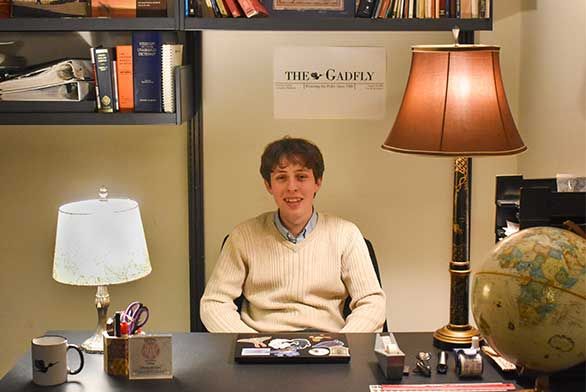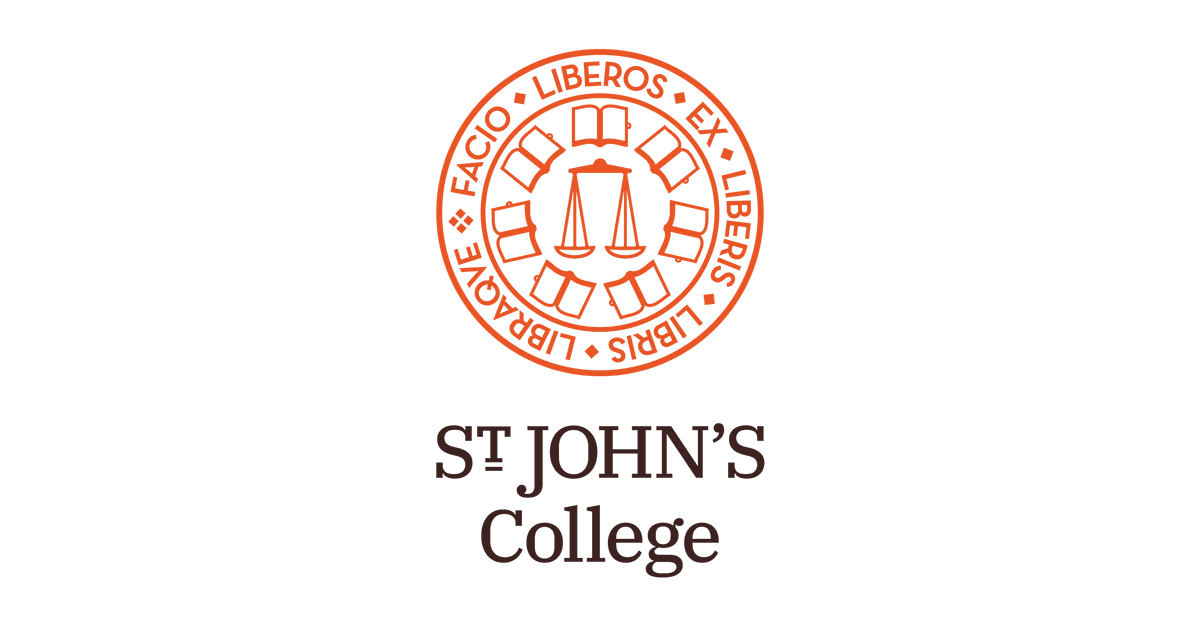The Editor Never Sleeps: Inside the 'Gadfly' Office of El’ad Nichols-Kaufman (A25)
By Gabriela Forte (A27)
At the southeast corner of the Annapolis campus’s front lawn stands the Barr-Buchanan Center, a looming brick building with large stone steps and marble columns leading up to a tall wooden door. Walk through this door and make your way down to the basement, and you will encounter several small offices. One of these is home to the Gadfly magazine, a mainstay of St. John’s Annapolis undergraduate campus culture since 1980.

The Gadfly’s office reflects the sensibilities and interests of El’ad Nichols-Kaufman (A25), its current editor-in-chief. Like any good Johnnie office, the shelves are weighed down with books: an Indiana map book (one of several U.S. states he’s called home), a Chesapeake Bay bird guide, an ancient Greek-English lexicon, and the Chicago Manual of Style, among others. Stacks of old and new Gadfly issues are laid out on the countertops, and perched atop the desk at which Nichols-Kaufman sits is a globe and a neatly arranged collection of office supplies.
Outside the office, Nichols-Kaufman’s life is a whirlwind of activities and academics. He is a lab assistant, the secretary of the Delegate Council, a member of the King William Players theatre troupe, and he participates in numerous choral singing groups on campus. He is also a member of the Shammai Jewish student group and has received a Hodson internship to work as a summer urban planning intern. And, of course, he heads the Gadfly, which is released every three weeks, as well as the Collegian, its news-focused sister publication that arrives biweekly as a one-page newsletter.
In short, Nichols-Kaufman is incredibly involved, even for a St. John’s student, most of whom are known for having eclectic interests. So, how does he do it all as an editor-in-chief?
“I think the key thing,” Nichols-Kaufman says, “is the wider support I have from other students. I don’t think I’d be able to hold up the Gadfly by myself if I didn’t have my group of assistant editors who are usually on it pretty early in the week editing articles, if I didn’t have writers who were so consistent about sending things in … Having the Collegian come out as one page every week for two weeks and then a Gadfly every three weeks is a good balance, because I have one kind of insane weekend and one editing week every three weeks. I build my schedule around that.”
He continues, “I think, like all things at the college, work for the Gadfly can end up being work for other things, like drafting essays [and] thinking about my senior essay. I’ve had conversations with friends that have been Gadfly news-related, and that’s something I love about St. John’s … My social life [is] very much intertwined with the work, but in the sense that the work doesn’t always feel like it’s work.”
Nichols-Kaufman, who graduates this spring, plans on pursuing architecture and urban planning. He credits the conversations he has had at St. John’s, as well as his own role in their cultivation, for the value he finds in urban planning as a career path. “The human element of it, the much more important question of how do we build a collective vision of what is good for community … That kind of conversation, I’ve realized, is essential to urban planning and is essential to St. John’s,” Nichols-Kaufman says. “You’re hearing a variety of different narratives, putting it together, and having something that, in some ways, is a voice of the college.”
Inspired by this desire for communal exchange, Nichols-Kaufman began working at the Gadfly as a writer during his freshman year, contributing articles on local and campus news. He has always found it essential that the student body be informed of the goings-on of their greater community, from board meetings to Annapolis City Hall decisions and local ordinances. Nichols-Kaufman then signed up to be the editor of the magazine’s “Logos” section, dedicated to news reports and campus narratives. This position gave him more involvement in operations and editorial work, including article selection, organization, and layout.
During his junior year, Nichols-Kaufman left the Gadfly to resuscitate and lead the long-dormant Collegian, dedicated to weekly news and shorter articles. Problems with irregular publication had led to lessened Gadfly student contributions and an overall waning of interest among the student body, causing Nichols-Kaufman to reconsider his efforts there.
“By my junior year I think I was more or less being seen as the heir apparent to the Gadfly,” he says. “I think general contributorship had kind of dropped off [that] year, and I was a little skeptical about running the Gadfly itself.” His work on the Collegian reinvigorated his sense of purpose and made him reconsider taking the larger job his senior year.
“It’s stressful but great fun to put [the Collegian] together, to really source all these different opinions and to feel that once a week something’s out on the tables everywhere across campus that you have helped put together, and that the discourse on campus is being, in a concrete way, facilitated by you,” Nichols-Kaufman says. “And I think running the Collegian … inspired me to go on, to continue doing that for the Gadfly this year.”
When Nichols-Kaufman became Gadfly editor-in-chief, he resumed a regular printing schedule, which had fallen to the wayside in the wake of the COVID-19 pandemic. He introduced a gonzo journalism fund to the paper’s budget to encourage creative and adventurous articles from contributors. He also introduced editorial and columnist positions to motivate a more organized submission process. (Students unaffiliated with the Gadfly staff are always welcome to submit, but having a staff allows for a more consistent flow of material.) Nichols-Kaufman additionally recognized that Johnnies’ busy lives often make it hard to submit regularly. To remedy this issue, he implemented concrete deadlines to incentivize student writers.
A more structured approach to the Gadfly is something Nichols-Kaufman has worked to maintain throughout the publication process as well. He finds it integral “to have something consistent, something [so that] when people come out of class on Thursday before seminar, either there’ll be a Collegian there for them to have a rifle through or there’ll be a Gadfly,” he says.
Even though Nichols-Kaufman has made certain changes to the paper’s operation, he has a deep appreciation for the Gadfly’s history. He has dedicated himself to a special archival project, digitizing old copies and funneling missing print copies into the Greenfield Library’s physical archives.
One thing Nichols-Kaufman has enjoyed throughout this process is rereading back issues and witnessing the ebb and flow of certain kinds of content and conversations depending on the editor, the magazine’s contributing staff, and the student body. “Looking back at the Gadfly’s history, it’s got a little bit of a dual personality problem; it simultaneously wants to be a newspaper and an arts magazine, and at various points one or the other personality has kind of dominated, but I don’t think it’s ever been a complete victory,” he says. “And I actually like that tension.”
The tension between ideas, interests, and identity is, in many ways, what makes the Gadfly so special. It is an essential part of the St. John’s experience to hear everyone’s voice, inside and outside of the classroom. Any student who has attended or is attending St. John’s knows how alike its student body can be, despite and often because of its differences. And student newspapers are just another opportunity to hear what everyone has to say. An editor so dedicated to compiling and presenting these thoughts is integral to campus culture, and the work that Nichols-Kaufman has done in the past year as editor-in-chief continues the Gadfly tradition while leaving a unique mark on its history.

